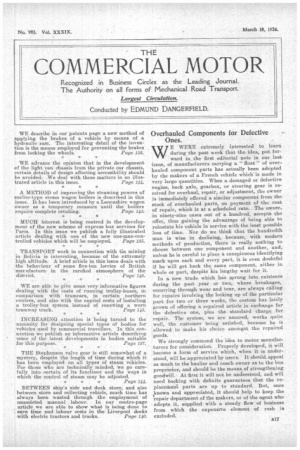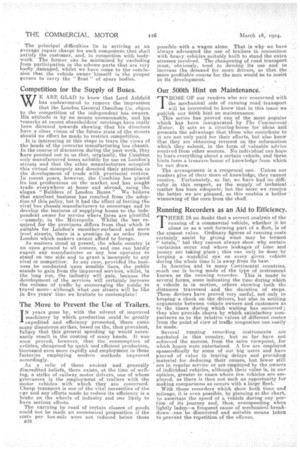Overhauled Components for Defective Ones.
Page 1

Page 2

If you've noticed an error in this article please click here to report it so we can fix it.
WE WERE extremely interested to learn during the past week that the idea, put forward in the first editorial note in our last issue, of manufacturers carrying a "float " of overhauled component parts has actually been adopted by the makers of a French vehicle which'is made in very large quantities. When a damaged or defective engine, back axle, gearbox, or steering gear is received for overhaul, repair, or adjustment, the owner is immediately offered a similar component from the stock of overhauled parts, on payment of the cost of repair, which is at a scheduled rate. The owner. in ninety-nine cases out of a hundred, accepts the offer, thus gaining the advantage of being able to reinstate his vehicle in service with the least possible loss of time. Nor do we think that the hundredth man is wise in declining, because, with modern methods of production, there is really nothing to choose between one component and another, and, unless he is careful to place a conspicuous identifying mark upon each and every part, it is even doubtful if he will get hack the same component, either in whole or part, despite his lengthy wait for it.
In a new trade which has sprung into existence during the past year or two, where breakages, occurring through wear and tear, are always calling for repairs involving the locking up of the particular partfor two or three weeks, the custom has lately grown of offering a repaired article in exchange for the defective one, plus the standard charge, for repair. The system, we are assured, works quite well, the customer being satisfied, because he is allowed to make his choice amongst the repaired goods.
We strongly commend the idea to motor manufacturers for consideration. Properly developed, it will become a form of service which, when it is understood, will be appreciated by users. It should, appeal as much to the haulier and coach owner as to the bus proprietor, and should be the means.of strengthening goodwill. At first it will not be understood, and will need backing with definite guarantees that the replaceihent parts are up to standard. But, once known and appreciated, it should help to keep the repair department of the makers, or of the agent who adopts it, supplied with a steady flow of business from which the expensive element of rush is excluded. The principal difficulties lie in arriving at an average repair charge for each component that shall satisfy the customer, and, in connection with bodywork. The former can be minimized by excluding from participation in the scheme parts that are very badly damaged, whilst we have come to the conclusion that the vehicle owner himself is the proper person to carry the " float " of spare bodies.
Competition for the Supply of Buses.
WE ARE GLAD to know that Lord Ashfield has endeavoured to remove the impression that the London General Omnibus Co. object to the competition of the independent bus owners. His attitude is by no means unreasonable, and his 'remarks at recent shareholders' meetings have really been directed towards showing that his directors have a clear vision of the future state-of the streets should no effort be made "to restrict competition. It is interesting at this stage to learn the views of the heads of the concerns manufacturing bus chassis. in the course of discussion during the past week, they have pointed out to us that, originally, the Combine only manufactured buses suitable for use on London's streets and that the other manufacturers accepted this virtual monopoly and directed their attention to the development of trade with provincial centres. In recent years, however, the Combine has placed its bus productions on the market and has sought trade everywhere at home and abroad, using the slogan "Builders of London Buses." We believe that excellent business has resulted from the adoption of this policy, but it had the effect of forcing the
, rival bus chassis manufacturers to encourage and to develop the business of supplying buses to' the independent owner for service where fares are plentiful —namely, in the Metropolis. Whilst the bus required for the provinces differs from that which is suitable for London's smoother-surfaced and more level streets, there is a prestige in an order from London which makers cannot afford to forego.
As matters stand at preent, the whole country is an open ground to all corners, and one can hardly expect any manufacturer or any bus operator to stand on one side and to grant a-monopoly to any rival or competitor. In any case, provided the business be conducted upon sensible lines, the public stands to gain from the improved services, whilst, in the Icing run, the industry will gain, because the development of the services will certainly increase the volume of traffic by encouraging the public to travel more—although what our streets will be like in five years' time we hesitate to contemplate!
The Move to Prevent the Use of Trailers.
IN years gone by, with the advent of improved machinery by which production could be greatly expedited and efficiency promoted, there came many disastrous strikes, based on the, then prevalent, fallacy that this general speeding up would necessarily result in the ousting of many hands. It was soon proved, however, that the consumption of articles, cheapened by quick and efficient production, increased even more rapidly and employment in those factories employing modern methods improved
• accordingly.
As a relic of these ancient .and generally discredited beliefs, there exists, at the time of writing, a strike of railway motor drivers, one of whose grievances is the employment of trailers with the motor vehicles with which they are concerned. Cheap transport is one of the vital necessities of the age and any efforts made to reduce its efficiency is a brake on the wheels of industry and one likely to have serious effects.
The carrying by road of certain classes of goods could hot be made an economical proposition if the costs per ton-mile were not reduced below those
1318 possible with a wagon alone. That is why we have always advocated the use of trailers in connection with heavy vehicles suitably built to stand the extra stresses involved. The cheapening of road transport must, obviously, tend to develop its use and to increase the demand for more drivers, so that the more -profitable course for the-men would be to assist in its development. .
Our 500th Hint on Maintenance.
THOSE HOSE OF cur readers who are concerned with the mechanical side of running road transport will be interested to know that in this issue we publish our 600th hint on maintenance: . This series has proved one of the most popular which has been inaugurated by The Commercial Motor. It acts as a elearing-honSe for ideas and presents the advantage that those who contribute to it are not only paid for their efforts, but also know that they are obtaining interest on the information which they submit, in the form of valuable advic,e received from other sources. No individual can hope to learn everything about a certain vehicle, and these hints form a treasure house of knowledge from which
he can draw. .
The arrangement is a reciprocal one. Unless our readers give of their store of knoikledge, they cannot receive. 'Fortunately, so far, we have had no diffieulty , in this respect, as the supply of technical • matter has been adequate, but the more we receive the better we are pleased, as this enables a baler winnowing of the corn from the chaff.
Running Recorders as an Aid to Efficiency.
THERE IS no doubt that a correct analysis of the running of a commercial vehicle, whether it be. alone or as a unit forming part of a fleet; is of the utmost value. Ordinary figures of running costs certainly assist by giving what may be termed P totals," but they cannot always show why certain variations occur and where leakagek of time and money are taking -place; this can only be done, by keeping a watchful eye on every given vehicle during the whole time it is away from its base.
In America and in many Continental countries, .much use is being made of the type of instrument known as the running recorder. This is made in several forms, some indicating the time during which a• vehicle is in motion, others showing both the distances traversed and the duration of stops. These devices have proved very useful, not only in keeping • a check on the drivers, but also in settling arguments between vehicle owners and customers as to the times during, which waiting has occurred ; they also provide.charts by which satisfactory bornnarisons as to the relative-values of different routes from the point of view of traffic congestion can easily be made. . Several running recording instruments are marketed in this country, but so far have not achieved the succeSs, from the sales viewpoint, for which hopes were ehtertained. A few are employed spasmodically by some of our big users and have proved of value in tracing ' delays and providing material for deducing their causes, but fewer still , are in regular service or are employed by the owners of individual vehicles, although their value is, in our opinion, greater in eases where few vehicles are employed, as there is then not such an opportunity for making comparisons as occurs with a, large fleet. With those recorders which show both time and mileage, it is even possible, by glancing at the chart, to ascertain the speed of a vehicle during any portion of its journey and, thus; overspeeding when lightly laden—a frequent cause of mechanical breakdown—can be -discovered and suitable means taken to prevent the repetition of the offence..




























